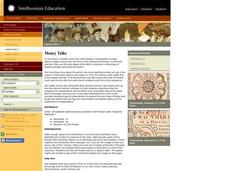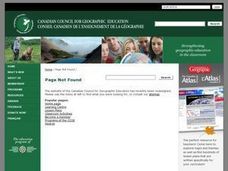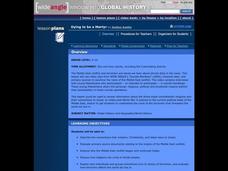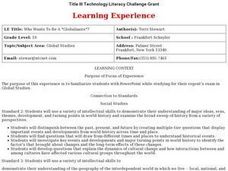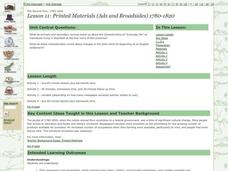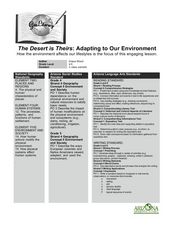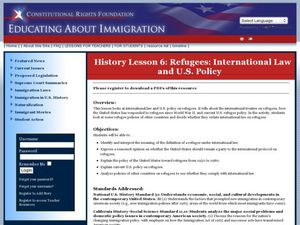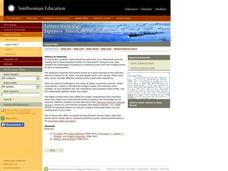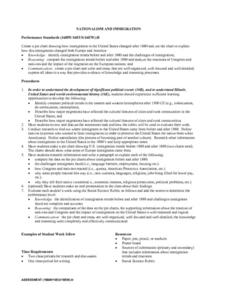Curated OER
Los Angeles Throughout the Years
Fourth graders study the history of the city of Los Angeles, investigating its variety of cultural traditions. They develop expertise on one specific decade in LA history.
Curated OER
Money Talks
Students move from fact finding to interpretation as they examine paper money from the time of the American Revolution. In the final exercise, they use the issue dates of the bills to construct a chronology of political changes during...
Curated OER
Why is the Past Important?
Students explore, examine and study why it's important to study the past and connect this importance with reasons why we should learn from the past and how cultures have changed over the years. They bring an object, photograph or a...
Curated OER
Dying to be a Martyr
Students study primary source document that describe the beginnings of the Middle East conflict. They survey the connections that Judaism, Christianity, and Islam have to Israel.
Curated OER
A World of Money
Students explore the traditions related to the creation of national currencies. The role currency plays in shaping a national or regional identity and the influences that the designers of world currency exert are examined in this lesson.
Curated OER
The Cherokee: Trail Where They Cried
Students read the Trail of Tears about the Cherokee Nation removal and write a letter pretending they are the grandparent of a Cherokee child. In this Trail of Tears lesson plan, students understand the changing of boundaries.
Curated OER
Who Wants To Be A "Globalnaire"?
Tenth graders research geography and the process of creating a Powerpoint presentation. In pairs, they design their own game show, writing geography questions, and creating a Powerpoint presentation for other students to play their game.
Curated OER
Gold Rush in Photos
Students examine historical images of the Alaskan Gold Rush and complete a worksheet to better explain this era. They create a PowerPoint related to the images.
Curated OER
Overcoming Censorship Through Art
Students examine and discuss government-imposed censorship of art and artists' methods for counteracting censorship. They view censored artwork, write a persuasive essay, and create an art piece.
Curated OER
Worth a Thousand Words
First graders examine the significance of the American bison to the American Indians of the Great Plains. They create a story in pictographs in the style of American Indians of the Plains.
Curated OER
Lesson 11: Printed Materials (Ads and Broadsides) 1780-1820
Young scholars use primary resources (gazettes, broadsides, advertisements) to consider life at the turn of the 18th century in Deerfield, Massachusetts. They infer observations about life in the nascent United States.
Curated OER
History of the American West
Ninth graders research early mining in California. They study the "placer method" for mining gold, which is surface mining that does not involve tunneling. They examine what it was like for the early miners to pan for gold with...
Curated OER
Speaking in Grave Tones
Fourth graders examine how a change in attitudes about death took place from the late eighteenth to the early nineteenth century and was embodied in gravestones, literature, and art.
Curated OER
The Desert is Theirs: Adapting to Our Environment
Students determine how animals and people adapt to the desert environment. In this desert lesson, students review vocabulary about the desert and how humans have to make changes to accommodate their environments. They listen to and...
Curated OER
Diet: You Are What You Eat
Third graders examine the issue of food quality to assess the dangers of pesticides, additives, and improper food preparation. After keeping food diaries and categorizing foods, they fill in food pyramids based on their journal entries....
Curated OER
Extra! Extra!
Students describe how plants and animals depend on each other. They see how living and nonliving environments change over time. They identify ways in which humans have changed their environment and the effects of those changes.
Curated OER
Invention Timeline
In this lesson, students Create a timeline of historical events, Identify patterns of change, Interpret data in a timeline.In this lesson, students use Inspiration to view progress over time as they develop
timelines highlighting...
Curated OER
Refugees: International Law and U.S. Policy
Students explore refugee policies. In this international law and U.S. policy instructional activity, students examine the U.S. policy on refugees between 1950 and 1980 as well as the current policy. Students examine the...
Curated OER
It's Alive! Using Microorganisms in Cooking
Learners create a KWL chart about food. In this chemistry lesson plan, students differentiate physical and chemical changes. They explain how microorganisms are used in food preparation.
Curated OER
Letters from the Japanese American Internment
Students examine letters of Japanese-American children during internment in World War II. They discover what it was like in the camps and how they were treated once they were released. They also view photographs of the camps.
Curated OER
Sam Cooke - Lesson 1
Students identify the impact of the social injustices and Civil Rights movement on Cooke's life and career. They create lyrics to a familiar song that express a personal struggle or concern.
Curated OER
Read Aloud: "The Bookshop Dog"
Students listen to the book "The Bookshop Dog" and discuss what happens when there is a change in their lives. They create a class T-chart about changes and feelings, develop a graph related to the story, and define key story vocabulary...
Curated OER
Scarification
Students examine the process of scarification. They use their prior knowledge to discuss how to change the appearance of the human body. They write a summary about what they have learned.
Curated OER
Nationalism and Immigration
Students use the internet to research how immigration patterns changed after 1880. Using this information, they create a pie chart to organize it effectively and discuss how immigration changed Europe and the United States. They also...

